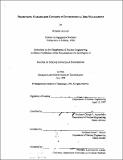Prioritizing stakeholder concerns in environmental risk management
Author(s)
Accorsi, Roberto, 1971-
DownloadFull printable version (6.748Mb)
Advisor
George E. Apostolakis.
Terms of use
Metadata
Show full item recordAbstract
The management of environmental programs affects a great variety of issues and involves several stakeholders with diverse, and often conflicting, concerns. Any methodology proposed for environmental decision making should, then, be capable of integrating technical and value-laden objectives in a framework which ensures process transparency. Furthermore, only a methodology simple and easy to implement can achieve public involvement at every level, and, with it, achieve a thoroughly informed decision. Classic decision making techniques have provided the tools to organize decision problems in a sound logical structure. Unfortunately, actual applications have shown that, when it comes to the practical quantification of stakeholder values, these tools may be too burdensome to apply. This is particularly so in cases where non-technical public is a fundamental part of the decision process. In this thesis, the focus is on a methodology developed to assess stakeholder preferences regarding a number of objectives of environmental restoration activities, such as the minimization of costs and the impact on human health and safety, and on its combination with the structural approach provided by classic methods. Stakeholder input is used to produce a first set of relative weights using the Analytic Hierarchy Process in combination with value trees. The set of preferences so obtained, as well as possible inconsistencies in their assessments, are discussed with the stakeholders to revise the weights and reduce inconsistency. The stakeholders always have the final word regarding the relative weights. The prioritization procedure is presented through a case study. Insights gained from this real life application are also presented.
Description
Thesis (S.M.)--Massachusetts Institute of Technology, Dept. of Nuclear Engineering, 1998. Includes bibliographical references (p. 132-134).
Date issued
1998Department
Massachusetts Institute of Technology. Department of Nuclear Science and EngineeringPublisher
Massachusetts Institute of Technology
Keywords
Nuclear Engineering